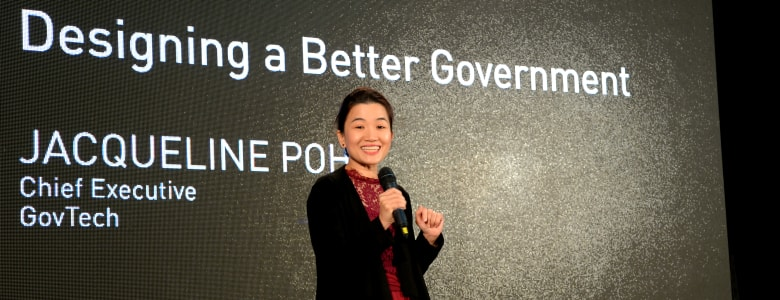Better Government by Design

We’ve all experienced the occasional frustration that comes with filling out unnecessary administrative forms, or navigating confusing government websites.
But here’s the good news: The Government is not oblivious to your pain.
In fact, it’s trying to design better systems that would make such inconveniences a thing of the past.
“Design has an incredibly important role to play in Government,” said GovTech chief executive Jacqueline Poh.
“Whether or not the public thinks that a policy, process or service has been designed with empathy, and with the user’s needs and feelings in mind, has a lot to do with how well it was designed.”
GovTech, Ms Poh explained, takes a multidisciplinary approach to problem solving, bringing together areas as diverse as design, data science, prototyping and behavioral economics to help government agencies better address the needs of citizens.
She was speaking at the Innovation by Design Conference 2017, held from 7-8 March as part of Singapore Design Week.
Also speaking at the same session were Mr Peter Barkman and Mr Reima Rönnholm of Finnish service design agency PALMU, who discussed their experiences with public sector design in the city of Helsinki, Finland.
They later joined Ms Poh in a panel discussion.
Putting citizens at the heart of services
When it comes to designing policies, processes and services, governments have often adopted an inside-out approach, taking what they consider to be the most important elements and pushing it out to the citizen.
While this has benefits for citizens, it also “has some flaws — the citizen’s views are not necessarily taken into account from the beginning” .
When Singapore’s Pioneer Generation Package — which offers generous healthcare subsidies to senior citizens — was rolled out in 2014, the initial reaction was one of confusion among some citizens, said Ms Poh.
It was only after the Government made changes to the way the package was communicated — by using dialects and making house visits to explain it to senior citizens— that it was better received.
“Design, when done upfront, can actually bridge citizen needs and policy objectives.”
An example of a service that has been greatly improved by better design is the letter the Ministry of Manpower (MOM) sends out to inform people that their work permits have been cancelled, and the next steps to take note of.
This letter used to be poorly laid out, and contained jargon that made it difficult to understand, said Ms Poh.
As a result, MOM found itself receiving calls from confused members of the public asking the same questions stated in the letter.
MOM has since completely overhauled the letter, making its design and language clearer and easier to read.
More importantly, it also added a prominent section to address readers’ top concern — the steps they needed to take after receiving the letter.
Focus groups and the use of technology such as eye-tracking software can also help government agencies gauge how effective their designs will be, she added.
In addition to services, government processes can also be improved by good design.
Designing away frustration
For example, small business owners applying for government grants used to have to submit a separate application to each government agency; often, they would discover that a grant was irrelevant to their business only after applying for it.
To address this, said Ms Poh, GovTech collaborated with the relevant government agencies to create a one-stop Business Grants Portal (BGP).
With this, business owners can just enter their information, and the system will then match the relevant grant to the business owner’s needs, removing the need to find specific agencies and grants during the application process.
Policies can also be streamlined, said Ms Poh, bringing up the example of excessive, unnecessary form-filling.
“We found that every agency made you fill out the same forms again and again, and sometimes the information requested wasn’t entirely relevant,” she said.
To reduce the need for this, GovTech helped create MyInfo, a service that citizens can use to automatically fill in commonly requested data fields on a range of government websites and online services.
The MyInfo service has applications beyond the public sector — the government is also working with several banks to implement it on their websites, so the public can experience greater convenience and ease in applying for a bank account.
Design in Government
For designers thinking about working in Government, there has never been a better time, said Ms Poh.
“The atmosphere is so receptive, and our means of capturing data have never been better.”
In addition, one aspect that is unique to a place like Singapore is the opportunity to design for 100 percent of the population, said Ms Poh.
“There are lots of opportunities to make a big difference. What you design can be a huge policy that affects your relatives and friends.”
Putting design and data together, concluded Ms Poh, would help create a more empathetic Government.
“We invite you to join us on this journey of bringing the ‘quant’ together with the heart, and pulling it all together with design.”
https://www.tech.gov.sg/media/technews/better-government-by-design
